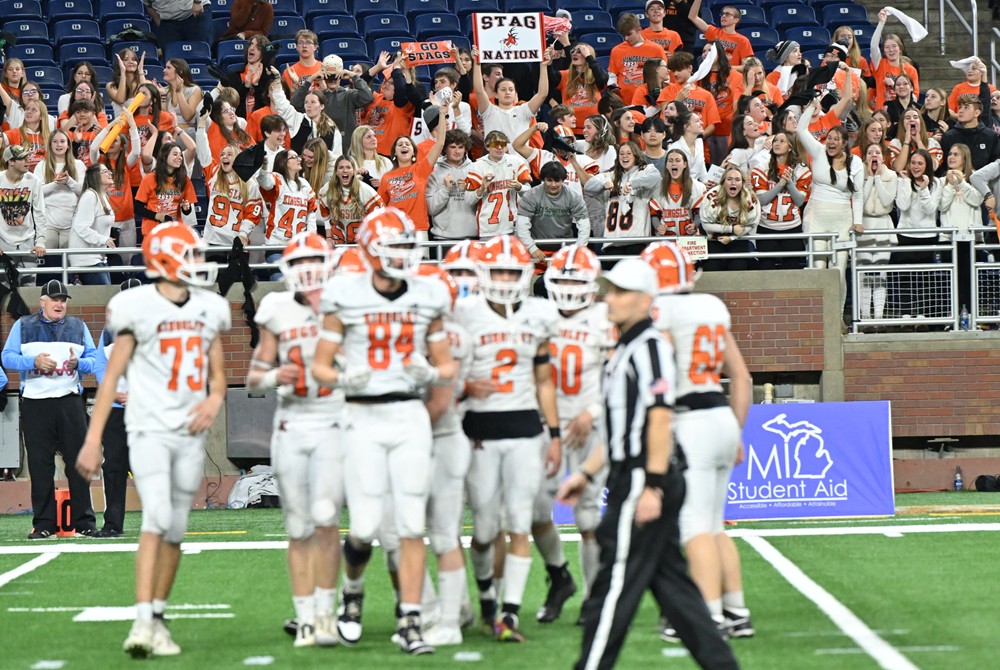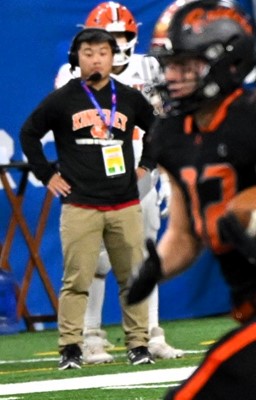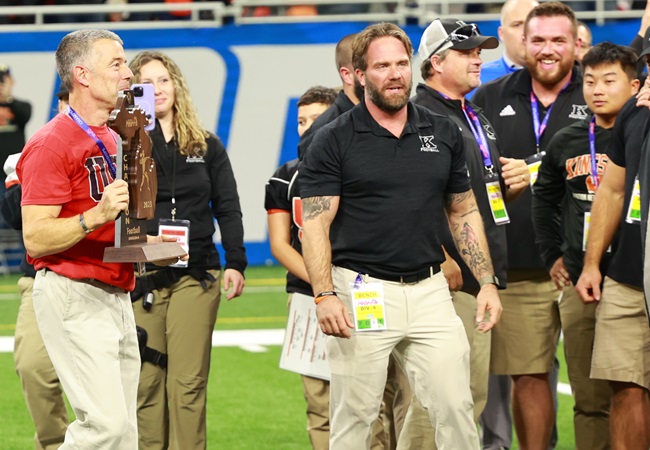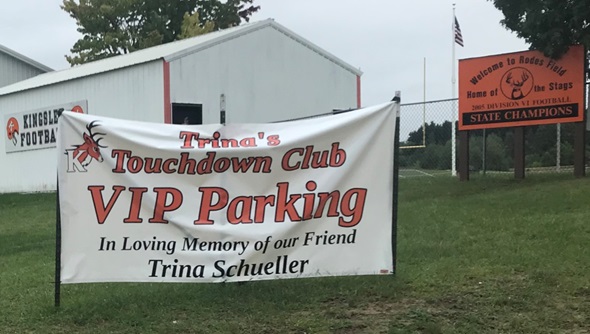
Turnaround Coaches: Study their Steps
April 27, 2016
 By Scott Westfall
By Scott Westfall
MSU Institute for the Study of Youth Sports
Turnaround leadership is often a popular topic within sports conversations, as many coaches are revered for their ability to transform a struggling team into a “winner.”
Turnarounds often are discussed in platitudes such as, “That coach has what it takes to turn this program around.”
While often talked about during the offseason, especially in the face of coaching vacancies, turnarounds are difficult to achieve. After all, if transforming a failing team into a successful one were an easy task, there would not be such an abundance of teams that struggle year-in and year-out.
As much as turnaround coaches are celebrated for their abilities to turn a losing program into a winner, very little scientific research has been devoted to analyzing coaches who have proven themselves as turnaround specialists. The steps and intangibles necessary for achieving a coaching turnaround have remained undetermined as this topic had never been examined from a scientific perspective – until now.
For the past year and a half, I have devoted the majority of my time to researching turnaround leadership in high school coaching, undertaking this study as the topic of my doctoral dissertation project. Research participants in this study included 11 high school football coaches from the state of Michigan who led dramatic turnarounds at their high schools within the last decade. The criteria for participant selection were:
• Prior to the coach’s arrival or appointment as head coach, the team finished (at least) three of the previous four seasons with a losing record (below .500 winning percentage), including a losing season immediately before the coach’s arrival or appointment.
• Within five seasons of the coach’s arrival, the team enjoyed (at least) three winning seasons (above .500 winning percentage).
Before their turnarounds occurred, these high schools had not experienced a winning season (on average) in 7.2 years, while five of the 11 schools had never qualified for the MHSAA Playoffs. However, upon being hired, the average time it took the coaches to achieve a winning record was 1.73 seasons. Moreover, the average time it took the coaches to qualify for the MHSAA Playoffs was 1.82 years. On top of this, each of the 11 teams qualified for the playoffs within three years of hiring their new coach.
The circumstances these coaches faced when they arrived were challenging to say the least, as all of the coaches entered a negative situation with poor team culture. These situations were characterized by losing streaks, cancelled seasons, dilapidated facilities, poor role models on the previous coaching staffs and a significant amount of parental pushback. Players and community members often were embarrassed by their football program. One coach described the situation by recounting, “During that time they were a doormat; everybody’s homecoming, a laughing stock. They were like the Bad News Bears.” Additional problems included low numbers, very little player development, and a low amount of commitment to the overall program.
One coach that I interviewed compared entering a turnaround situation to building a well. He stated, “You may not have success on the surface initially, but if you dig nice and deep and build the well right, there is water down there. It’s going to be some work and it might not come up right away – it takes some pumping. But if you build it right, it will happen.” In this article I will attempt to encapsulate 16 months of research, 191 pages of interview transcriptions, 2,278 miles driven across the state of Michigan, and countless hours spent with 11 turnaround coaches, in order to present to you the nucleus of what it takes to turn around a failing high school program.
The coaching philosophies of the majority of the coaches were characterized as “educational athletics.” This involved coaches striving to do things the right way, viewing their job as an extension of the classroom, implementing a character development program, and using football as a vehicle to teach life skills to players. Furthermore, their greatest strengths were revealed to be coaching/leadership skills, along with the ability to develop strong relationships with their players.
Coaches unanimously agreed that upon their arrival immediate changes needed to be made to the team’s culture. These changes included prioritizing team workouts, altering visible elements like the organization of practices, offensive and defensive schematics, team logos, along with placing positive role models in front of the players. Other changes to team culture happened through improved coach-athlete relationships, giving players a better football experience, and purging the program of negative people. One coach used the term, “Weeding the roses,” which means getting rid of the negative people in the program in order to let the better parts grow and prosper.
All of the coaches developed some type of vision for their program. The most common visions involved transforming their team into a top-level program, and for their players to conduct themselves as quality human beings. Winning games, competing with the best teams in their division, and playing for MHSAA championships marked becoming a top program. While winning was a major component of the coaches’ visions, developing quality human beings was revealed to be just as essential. This was evident as several coaches remarked that their most well-behaved kids were also their most productive players, and that doing things right in school and in the community often equates to wins on the football field.
To build upon their visions, each of the coaches formulated some type of plan or “blueprint” to execute their turnarounds. The majority of the coaches’ plans were constructed around developing positive coach-athlete relationships and employing off-season strength and conditioning programs. While all of the coaches’ plans eventually yielded a great amount of success, not all parties bought into them initially. Some of the players needed to see proof that the team could win games before they were completely sold. In order to create buy-in, the coaches used various approaches to connect with players and sell their plan. These methods included team activities, cultivating relationships with players, continuously selling their vision, hiring/retaining quality assistant coaches, and entering the situation with some sort of previous expertise. Although it may take time, the coaches stressed the importance of the players buying into their vision. As one of them decreed to his team, “The quicker you buy in, the quicker we win.”
Early indicators that a turnaround was commencing included winning games or making significant strides off of the field through positive coach-athlete relationships. Sources of sustained changes included a win streak or an increased level of commitment from the players. Clear indicators that the program had undergone a turnaround included the players adopting a new mentality filled with trust and confidence, along with the program reaching unprecedented levels of success, such as competing with the best teams, completing an undefeated season, and/or making the playoffs consistently.
Character development emerged as a strong component of this study, as 100 percent of the coaches reported that it played a significant role in fostering turnarounds. The coaches also indicated that they deliberately teach character in practice and use coaching as a platform for character development.
In hindsight, an outside observer may assume that these coaches were destined to succeed and their plans were met with little resistance. However, after examining their roads to turnaround success, most of them met several barriers along the way. Early obstacles included widespread mental challenges among players such as a lack of confidence and/or trust. Other early barriers included parental pushback and some cases of overt interference. After the turnarounds were complete, the coaches’ problems did not disappear; they simply changed form, as complacency became the new problem on the team. A potential root of this complacency was the addition of younger players who thought that success would happen automatically simply because of the program’s prior achievements.
The coaches were quick to acknowledge that the turnarounds would not have been possible without the excellent support they received. Their greatest source of help came from their assistant coaches who contributed both tangible and psychosocial support. Tangible support was seen through the assistants performing administrative duties and overseeing strength and conditioning sessions. Meanwhile, psychosocial support came in simple ways, such as listening, giving advice, and showing belief in the head coach. As one coach stated, “You’re only as good as the people you have around you.”
Team turnarounds are not officially complete until a team maintains the success it has built. In order to avoid complacency and sustain momentum, the coaches recommended that coaches and players find ways to keep reaching higher. In order to do this, coaches recommended talking to players about their team goals and what they want their legacies to be. To help sustain momentum, coaches stressed that it is often the little things that matter the most, such as effort, team discipline, player accountability, and positive attitudes.
The strongest theme that emerged from this study was the importance of coach-athlete relationships. All of the coaches believed that relationships are imperative to fostering turnarounds. It was also emphasized that relationships are crucial for sustaining long-term success. In essence, coaches may experience some momentary success by taking shortcuts with superior talent, however, strong relationships are the “X-factor” that will sustain the program over the long run. While the approaches of building relationships were diverse, what mattered most was coaches spending time with players in both structured and unstructured team activities, and simply showing players that they cared about them as people as much as they did as football players.
Steps of a Turnaround
(When turnarounds happen, they usually happen in this order)
1. Establish new leadership
2. Assemble a staff of positive role models
3. Gather information about the program
4. Create the vision
5. Make a plan and communicate it
6. Create buy-in from players and other key people
7. Change behavior – This is the impetus of the turnaround
8. Create and celebrate early wins
9. Don’t let up – Keep setting new goals and reaching higher
10. Complacency is the enemy: Make sure change sticks!
Intangibles Checklist
(These are the little things that people cannot see or do not talk about, yet they often matter the most)
1. Positive relationships between coaches and players. Build these by spending time with players and showing them you care about them as a person.
2. Establishment of a strength and conditioning program. All successful turnarounds were led by coaches who implemented a respectable offseason training program.
3. Display an undeniable belief that your vision and the plan will produce successful results. Continuously sell your plan and give players the reasons behind why you do what you do. Be prepared to stand tall and adhere to your vision when adversity strikes.
4. Generate player buy-in through team activities. Remember that sports are supposed to be FUN. Plan structured and non-structured activities to generate fun, excitement and team cohesion!
5. Demand excellence of your players off the field. Promote educational athletics and use your platform as a coach to teach character and life lessons to your players.
6. Outwork your opponents in everything you do. Arrive earlier. Stay later. Go above and beyond what your competitors are doing. Set the tempo that hard work is the new norm and it starts with you.
7. Remember that the little things matter. Take the time to ensure that your team always has the right effort, attitude and discipline, as well as accountability to the program and each other.
Scott Westfall spent 10 years as a teacher, coach, and athletic director in Fort Collins, Colo. He is currently finishing his Doctorate at Michigan State University, with an emphasis in Sport Psychology and Athletic Administration, and assisting the MHSAA with its student leadership programs. Westfall is a former athlete who participated in football, wrestling, tennis and cross country at the high school level, and rugby at the collegiate level. Please feel free to contact Scott if you would like a copy of his full dissertation. Scott also performs speaking engagements at conferences on various topics within educational athletics. He can be reached at [email protected]

Football Title Reflects Kingsley's Current Success, Recalls Loved Ones Passed
By
Tom Spencer
Special for MHSAA.com
December 1, 2023
Kingsley football fans have become pretty familiar with VIP parking for home games over the last couple of seasons.
 They may just start looking for a Kingsley VIP lot at Ford Field. The Stags just captured the MHSAA Division 6 championship trophy with a 38-24 victory over Almont, their second Finals championship and first since 2005.
They may just start looking for a Kingsley VIP lot at Ford Field. The Stags just captured the MHSAA Division 6 championship trophy with a 38-24 victory over Almont, their second Finals championship and first since 2005.
The road to the Finals started with Kingsley hosting two playoff games, allowing great use of the VIP Parking of Trina’s Touchdown Club. The lot is adjacent to the school’s Rodes Field and provided in loving memory of Katrina “Trina” Kay Schueller, who passed away Oct. 21, 2021, at Munson Medical Center.
Those playoff games filling Trina’s Touchdown Club’s parking lot featured wins over Mason County Central 61-12 and Manistee 37-18, and 51-27 over Gladstone in the Regional Final. Kingsley then traveled down the road and defeated Reed City 37-7 in the Semifinal.
There may not have been designated VIP parking in Cadillac and Ford Field for the Stags’ followers, but there were a lot of VIPs at both stadiums with Schueller on their minds. Pretty much everyone with an affiliation with the highly-successful program or familiarity with the community’s struggles have become VIPs to the Kingsley coaching staff and many others.
Most certainly among the VIPs are head coach Tim Wooer, assistant coach Conner Schueller, his brother Carter Schueller, and his father Mike Schueller.
Conner was set to play the biggest regular-season game of his career the day after his mom passed. It was the regular-season finale against rival Traverse City St. Francis.
Wooer vividly remembers the moments leading up to that matchup, noting how difficult it was for Conner. But his then-fullback and now-assistant coach demonstrated amazing strength and maturity he stills exhibits today.
 “He’s in his senior football season, and his mom is in the hospital for four weeks — he’s balancing that playing football and going to school,” Wooer recalled. “And then she passes, and he has the strength to come back to school and deliver the news to our team.
“He’s in his senior football season, and his mom is in the hospital for four weeks — he’s balancing that playing football and going to school,” Wooer recalled. “And then she passes, and he has the strength to come back to school and deliver the news to our team.
“I am sobbing watching this kid, and I’m just amazed,” Wooer continued. “The next night is Parents Night, and he’s on the field with his dad and brother without his mom.”
Conner still played, making a 4th-down goal line tackle to prevent a St. Francis touchdown. The Gladiators won the game, but Conner won the day, conquering much just to dress for the game.
The Stags went on to playoff wins over Kingsford 28-10 and Clare 32-6. They bowed out with a 33-18 Regional loss to Frankenmuth.
Conner’s junior year of 2020 had been cut short as the Kingsley was forced to forfeit its District Final to Reed City because several players and coaching staff tested positive for COVID-19. The Stags had Ford Field in their minds that season too after playoff wins over 38-13 Standish-Sterling 38-13 and Gladwin 63-16.
Conner, who celebrated his 20th birthday at Saturday’s Final, remembers his playing days and the challenges presented him.
“At the time it was ‘she’s not there,’ especially my senior year she wasn’t there to watch me and finish it out, but I know she’s watching above,” he said. “We were about to go play Reed City my junior year for Regionals, and everyone got sick and it ended our season unfortunately.”
Those challenges were on his mind at Ford Field, and running through his mind when he saw his brother and father in the stands. Carter, now a senior at Kingsley, had been unable to play football due to injuries.
“I thought about my brother – he unfortunately didn’t play this year due to his injuries, and I don’t really blame him for that,” Conner said. “I thought about him as well because it was just me and my dad and my brother now.
“It was very emotional,” Conner continued. “I got a glimpse of him in the strands.”
Carter also was filled with gratitude for the coaching staff for welcoming and mentoring him. He had become keenly aware of the amount of time coaches spend away from family at practices and going through film.
In addition to his family, Conner was thinking about many others in the Kingsley community – and other senior classes like his that didn’t get the chance to celebrate a championship.
He also was thinking about Justin Hansen, a 2003 graduate of Kingsley. Hansen was a captain on the 2002 conference championship team. He went on to become a special-operations Marine sergeant and was killed in action July 24, 2012, while deployed in Afghanistan. Hansen was on patrol as part of an operation in search of a high-value target when his team was hit with small arms fire.
 On Saturday, Wooer was wearing a red T-shirt with the letters “USA” on the front and the name “Hansen” on the back. It also featured the number 54, Hansen’s in high school.
On Saturday, Wooer was wearing a red T-shirt with the letters “USA” on the front and the name “Hansen” on the back. It also featured the number 54, Hansen’s in high school.
Wooer, who turned 54 in July, wore the shirt in Hansen’s memory knowing Hansen would be on the veteran coach’s mind and symbolizing Hansen’s presence with the team at Ford Field.
Wooer wants to make sure Hanson is never forgotten and reminds the soldier’s family the entire community remains behind them.
“I believe it is part of our job as a community to show our love to this family and help in any way possible to help them get through this process,” Wooers said. “After the funeral, we all went about life.
“We certainly still think about Justin and feel the pain,” he continued. “But nothing like a family does.”
Hansen’s tragic passing led to the creation of the annual Patriot Game in Traverse City in 2012 while Wooer was coaching Traverse City West. The game features crosstown rivals West and Traverse City Central every year and strives to honor veterans, first responders, active duty military, and area heroes who died while serving their country.
Saturday’s win over Almont left Wooer emotionally exhausted after all the preparations to do it right for the senior class, the school, the Kingsley community, the Schueller family and Hansen. Collectively, they’ve really become more like a family to the Stags coaching staff and many, many others.
“In terms of emotions, there is no doubt Justin was on my mind throughout the game,” Wooer said. “Trina and Conner have been – those are two huge pieces.
“And, a lot of my thoughts are with the seniors,” he continued. “You want to win the game, but also it is your last time with them.”
Wooer has learned a lot from his former players and coaches over the years. He’s become close friends with many of them, going back to his early days of coaching as a student-teacher at Elk Rapids. He also coached at Farewell and Traverse City West, the latter from 2008-2017 after a first tenure at Kingsley. He returned to Kingsley in 2018.
Schueller is among several former players and coaches who have been on Wooer’s coaching staffs over the years. Several continue today.
“I could give you lots of other stories about kids I have had,” Wooer said. “There comes this transition where they turn into such amazing men, you catch yourself every once in a while saying, ‘I want to be like him.’
 “You get this huge smile on your face because you’re so proud of them, just like a mother or father would,” Wooer continued. “A coach always looks at his players like they’re part of his family.”
“You get this huge smile on your face because you’re so proud of them, just like a mother or father would,” Wooer continued. “A coach always looks at his players like they’re part of his family.”
In addition to Conner, current assistants with long-term relationships with Wooer are Tom Kaleita, Kyle Smith, Ryan Zenner, Dan Goethals, Josh Merchant, Jordan Bradford, Steve Klinge, Connor Schueller, Mike Arlt, Larry Mikowski, Bobby Howell, Rob Whims and Jason Morrow.
This year’s seniors were Jon Pearson, Eli Graves, Skylar Workman, Gavyn Merchant, Max Goethals, Evan Trafford, Bode Bielas, Grant Kolbusz, James Person, Caleb Bott, Trenton Peacock, Noah Scribner and Gavin Dear. They and the coaching staff will be the center of attention as the community celebrates the football team at 7 p.m. this evening in the high school gymnasium.
The seniors probably won’t need VIP parking tonight. But if it would help, Conner would surely make arrangements to utilize Trina’s Touchdown Club. He’d have to add a shuttle though as Rodes Field is about a mile away from the school.
“It feels amazing — I don’t think it really hit any one yet, but I am sure it will,” Conner said. “After we won, it is truly something – it is something else I can’t explain.
“The seniors finally won it the way they were supposed to,” he continued. “It was a good class of seniors.”
 Tom Spencer is a longtime MHSAA-registered basketball and soccer official, and former softball and baseball official, and he also has coached in the northern Lower Peninsula area. He previously has written for the Saginaw News, Bay County Sports Page and Midland Daily News. He can be reached at [email protected] with story ideas for Manistee, Wexford, Missaukee, Roscommon, Ogemaw, Iosco, Alcona, Oscoda, Crawford, Kalkaska, Grand Traverse, Benzie, Leelanau, Antrim, Otsego, Montmorency, Alpena, Presque Isle, Cheboygan, Charlevoix and Emmet counties.
Tom Spencer is a longtime MHSAA-registered basketball and soccer official, and former softball and baseball official, and he also has coached in the northern Lower Peninsula area. He previously has written for the Saginaw News, Bay County Sports Page and Midland Daily News. He can be reached at [email protected] with story ideas for Manistee, Wexford, Missaukee, Roscommon, Ogemaw, Iosco, Alcona, Oscoda, Crawford, Kalkaska, Grand Traverse, Benzie, Leelanau, Antrim, Otsego, Montmorency, Alpena, Presque Isle, Cheboygan, Charlevoix and Emmet counties.
PHOTOS (Top) Kingsley students support their classmates during Saturday’s Division 6 Final at Ford Field. (2) Stags assistant coach Conner Schueller watches from the sideline during an Almont run back. (3) Kingsley coach Tim Wooer, in red, prepares to present the championship trophy to his team including Schueller, far right. (4) Trina’s Touchdown Club welcomes members to the VIP lot adjacent to the Kingsley stadium. (Ford Field photos by Hockey Weekly Action Photos; touchdown club photo courtesy of the Kingsley football program.)

